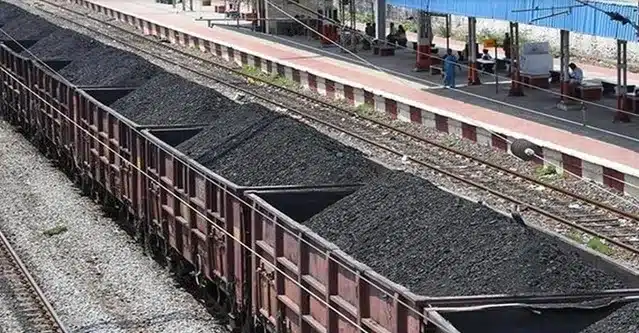What’s in today’s article?
- Why in News?
- Coal Quality and Gradation
- What are the characteristics of Indian coal?
- What is Clean coal?
- Future of Coal in India
Why in News?
- A recent report by the Organized Crime and Corruption Reporting Project claims that in 2014, the Adani Group falsely labeled low-grade Indonesian coal as high-quality. They inflated its value and sold it to Tamil Nadu’s power generation company, TANGEDCO.
- The Organized Crime and Corruption Reporting Project is a venture backed by billionaire hedge fund manager and philanthropist, George Soros.
Coal Quality and Gradation
- Understanding Coal Quality
- Coal quality is determined by its Gross Calorific Value (GCV).
- GCV is the amount of heat or energy that can be generated from burning the coal.
- Coal being a fossil fuel is a mixture of carbon, ash, moisture and a host of other impurities.
- Higher carbon content indicates higher quality or grade of coal.
- Coal quality is determined by its Gross Calorific Value (GCV).
- Types of coal
- Coal is characterized into different categories:
- Non-coking coal where grading is based on Gross Heat content;
- Coking Coal where grading is based on ash %; and
- Semi coking coal and weakly coking coal where grading is based on ash and moisture %.
- Coal is characterized into different categories:
- Coal Grades
- The higher the available carbon in a unit of coal, the greater is its quality or ‘grade.’
- There are 17 grades of coal, from grade 1 (highest quality) to the lowest grade.
- Grade 1 coal yields over 7,000 kcal/kg, while the lowest grades yield 2,200-2,500 kcal/kg.
- Application Context
- The usefulness of coal depends on its application, such as in thermal power plants or steel production, each requiring different types of coal.
- E.g., Non-coking coal is used in thermal power plants. It can have higher ash content but still generate sufficient heat for boilers and turbines.
- Coking Coal is essential for steel production, requires minimal ash content.
- The usefulness of coal depends on its application, such as in thermal power plants or steel production, each requiring different types of coal.
What are the characteristics of Indian coal?
- Low in calorific value
- Indian coal has historically been evaluated as being high in ash content and low in calorific value compared to imported coal.
- The average GCV of domestic thermal coal ranges from 3,500-4,000 kcal/kg compared to imported thermal coals of +6,000 kcal/kg of GCV.
- High ash content
- The average ash content of Indian coals is more than 40% compared to imported coal which has less than 10% ash content.
- Hence, high-ash coal when burnt results in higher particulate matter, nitrogen and sulphur dioxide.
- Government Policies
- Since 1954, the government has controlled coal prices to discourage the use of high-grade coking coal for power generation.
- To balance coal production, power needs, and pollution, the government recommends using imported coal with lower ash and moisture content.
- The Central Electricity Authority (CEA) in 2012 recommended blending 10-15% imported coal with Indian coal for power boilers designed for low-quality domestic coal.
What is Clean coal?
- About
- Clean coal refers to technologies and practices designed to reduce the environmental impact of coal energy production.
- In clean coal, the carbon content has been increased by reducing its ash content.
- These methods aim to make coal a cleaner energy source by reducing its environmental and health impacts.
- Clean coal refers to technologies and practices designed to reduce the environmental impact of coal energy production.
- Production of clean coal
- some key aspects of clean coal:
- Carbon Capture and Storage (CCS): Capturing carbon dioxide emissions from coal-fired power plants and storing them underground to prevent them from entering the atmosphere.
- Coal Washing: Removing impurities from coal before it is burned, which can reduce emissions of ash, sulfur, and other pollutants.
- Flue Gas Desulfurization (FGD): Also known as scrubbers, this technology removes sulfur dioxide from the exhaust flue gases of coal-fired power plants.
- Gasification: Converting coal into synthetic gas (syngas), which can be burned more cleanly than coal.
- Advanced Combustion Techniques: Improving the efficiency of coal combustion to reduce emissions and increase energy output.
- some key aspects of clean coal:
- Disadvantages associated with coal washing
- Coal plants use washing techniques, employing blowers or baths to remove ash and moisture.
- However, this process is costly and increases power production expenses.
- Coal Gasification
- An alternative method is coal gasification, converting coal into gas.
- Integrated Gasification Combined Cycle (IGCC) systems use steam and pressurized air or oxygen to create syngas (carbon monoxide, hydrogen, CO2, water vapor).
- Syngas is cleaned and burned in gas turbines, producing electricity.
- IGCC increases coal efficiency by generating both steam and syngas.
Future of Coal in India
- Production
- India in 2023-24 produced 997 million tonnes of coal, an 11% growth over the previous year.
- Most of this was produced by the state-owned Coal India Ltd and its subsidiaries.
- Coal is the mainstay of India’s energy economy
- Despite stated commitments to transition India’s electricity sector away from fossil fuel, coal is the mainstay of India’s energy economy.
- Change is in the air
- For the first time this year, renewable energy accounted for 71.5% of the record 13.6 GW power generation capacity added by India in the first quarter of this year.
- During this period, coal’s share (including lignite) of total power capacity dropped below 50% for the first time since the 1960s.
Q.1. What is Central Electricity Authority (CEA)?
The Central Electricity Authority (CEA) is a statutory body in India that advises the central and state governments on all technical aspects of the power sector.
Q.2. What is Gross Calorific Value (GCV)?
Gross calorific value (GCV), also known as higher calorific value (HCV) or high heat value, is the maximum amount of heat produced when a unit of fuel is completely burned and the combustion products have cooled to room temperature. GCV is made up of the net calorific value, plus the energy in the exhaust gases and water vapor produced during combustion.
Last updated on December, 2025
→ Check out the latest UPSC Syllabus 2026 here.
→ Join Vajiram & Ravi’s Interview Guidance Programme for expert help to crack your final UPSC stage.
→ UPSC Mains Result 2025 is now out.
→ UPSC Notification 2026 is scheduled to be released on January 14, 2026.
→ UPSC Calendar 2026 is released on 15th May, 2025.
→ The UPSC Vacancy 2025 were released 1129, out of which 979 were for UPSC CSE and remaining 150 are for UPSC IFoS.
→ UPSC Prelims 2026 will be conducted on 24th May, 2026 & UPSC Mains 2026 will be conducted on 21st August 2026.
→ The UPSC Selection Process is of 3 stages-Prelims, Mains and Interview.
→ UPSC Result 2024 is released with latest UPSC Marksheet 2024. Check Now!
→ UPSC Prelims Result 2025 is out now for the CSE held on 25 May 2025.
→ UPSC Toppers List 2024 is released now. Shakti Dubey is UPSC AIR 1 2024 Topper.
→ UPSC Prelims Question Paper 2025 and Unofficial Prelims Answer Key 2025 are available now.
→ UPSC Mains Question Paper 2025 is out for Essay, GS 1, 2, 3 & GS 4.
→ UPSC Mains Indian Language Question Paper 2025 is now out.
→ UPSC Mains Optional Question Paper 2025 is now out.
→ Also check Best IAS Coaching in Delhi

















